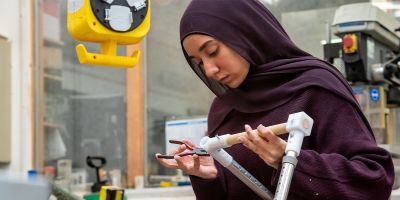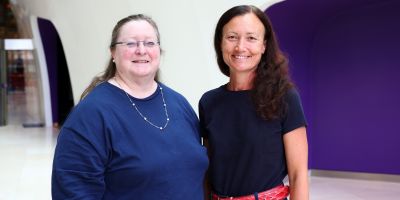Leeds celebrates innovation and inclusivity on National Engineering Day

The University of Leeds is putting innovation, impact, and inclusivity at the forefront of National Engineering Day 2024, with a special focus on inspiring the next generation of engineers.
Organised by the Royal Academy of Engineering (RAEng), this year’s event (13 November) celebrates the unsung heroes of the field – role models who showcase the possibilities of a career in engineering.
Leeds continues to support this national effort by collaborating with local communities, industry partners, and fellow universities to push the boundaries of what’s possible, empowering future experts to keep the University at the cutting edge of engineering.
With a commitment to championing diversity, Leeds is working to inspire a new wave of engineers who will shape the future of the industry – one that has deep roots in the city, which celebrates two of its most groundbreaking pioneers in 2024.
A big year for Leeds’ engineers
This year is special for engineers in Leeds. In 2024, the University partnered with Smeaton300 to celebrate the 300th anniversary of the birth of John Smeaton: an 18th-century trailblazer who coined the phrase “civil engineering” and, in doing so, established a new profession dedicated to using engineering for the benefit of society.

Most importantly, Smeaton believed in sharing knowledge, opting to never patent his work. This selfless approach allowed the UK, and world, to flourish with his cutting-edge building techniques, which continue to influence modern architecture.
Leeds also marked another major engineering anniversary: 200 years ago, on 21 October 1824, English bricklayer and stonemason Joseph Aspdin secured a patent for his invention of Portland cement, a pivotal material in construction.
Aspdin, who had experimented with cement production since setting up his business in a yard next to Leeds’ Briggate in 1817, created modern cement, which became a cornerstone of the building industry. It’s something our School of Civil Engineering continues to explore and refine, meeting eco-friendly challenges and Net-Zero targets.
How we’re engineering inclusivity
In September, Leeds became the central force in a novel initiative to bolster inclusivity within the UK’s engineering, physical, and mathematical sciences (EPMS) sectors.
The EDI Hub+, led by Leeds and partnering with seven universities across the UK, brings together the research and innovation community to leverage collective knowledge. By uniting diverse voices and promoting collaborative efforts, this first-of-its-kind concept aims to transform equality, diversity and inclusion in the engineering, physical, and mathematical sciences.

Leeds' EDI champions, L-R top: Louise Jennings, Vania Dimitrova, Lisa Hill; L-R bottom: Lisa-Dionne Morris, Lee Mason, Bharat Pokhrel.
Learn more about the EDI Hub+.
Supporting our community
Engineering goes so much further than our labs, which is why we love to support our local community – and inspire the next generation of young engineers.
In March, we debuted The Mechanics of Life: a powerful film, recorded in our state-of-the-art Sir William Henry Bragg Building, which combined engineering and ballet to help change perceptions of engineering by introducing new and diverse audiences to the mechanics of movement through dance – and create lasting relationships between art and science.
Mechanics of Life from Northern Ballet on Vimeo.
The project, funded by the Royal Academy of Engineering and led by Dr Briony Thomas, was the culmination of a ten-month collaboration between the University of Leeds, Northern Ballet, and Batley Girls’ High School.
In summer 2024, we also finally unveiled our ground-breaking collaboration between engineers, technicians, and designers: a show-stopping carnival costume, featuring mechanical elements previously thought “impossible” to make by hand, which led the parade at the world-famous Leeds West Indian Carnival.

The carnival dress, modelled by Khadijah Ibrahiim, one of Yorkshire’s most celebrated poets and Leeds alum, surrounded by the technicians who worked on the outfit. Credit: Alex Beldea.
The striking garment, which is 3m in diameter, more than 3m high, and weighs around 25kg, was themed around Afrofuturism, using traditional techniques and fabrics to celebrate the future while remembering the past – a beautiful collision of technology, precision engineering and artistry.
Most recently, a team featuring the School of Civil Engineering’s Dr Alice Macente worked with Leeds Galleries and Museums to explore the secrets of a world-changing model locomotive from 1811 for the first time in over two centuries, using advanced 3D scanning technology.

John McGoldrick, of Leeds Museums and Galleries, holding Matthew Murray's model steam locomotive. (Credit: Leeds Museums and Galleries)
The historic miniature train, which was created by esteemed engineer Matthew Murray just one year before he designed and built the Salamanca – the world’s first commercially viable steam locomotive – helped Murray demonstrate his revolutionary ideas to investors, therefore playing a crucial role in the Industrial Revolution and the history of rail transport.
Reaching for the stars
Leeds Materials Science alum Matthias Maurer spent 175 days on the International Space Station in 2022 – and in October 2024, he returned to Leeds to meet and inspire Faculty staff, students and alumni.
However, his meeting with students from Leeds University Rocketry Association (LURA) – a student-led, multi-discipline engineering team who design, build and fly sub-orbital rockets – proved to inspire and impress him, too, as he celebrated LURA’s advanced, and potentially record-breaking, understanding of rocket technology.

Members of the LURA team with astronaut and Leeds alum Matthias Maurer.
Tiny tools, huge potential
Our expertise in electronic, electrical, and mechanical engineering has led to a huge boost in Leeds’ reputation for cutting-edge robotics. We’ve showcased vine-like robots that can navigate lungs, potentially transforming cancer treatment; the Bragg Centre for Materials Research also created a nanosurgical tool 500 times thinner than a human hair, which could give never-before-seen insights into cancer treatment resistance.
Our engineers are also working with partners from across the UK to raise the profile of British robotics on a global scale. In May, we became part of a £34 million, UKRI-funded national research hub to support the UK’s transition to a circular manufacturing ecosystem. Leeds’ role will focus on delivering a robotics-enabled sustainable future for the industry.
The robotics community relies on its own unsung heroes: Research and Autonomous Systems Technicians. In March, this crucial network was given a £2 million boost through UKRAS STEPS, which aims to create a dynamic, person-driven strategic technology platform – and empower technicians to develop themselves within an inclusive community, enhancing the environment and delivering of world-leading research.
National recognition
The last 12 months have proved highly successful for our engineering colleagues, with many recognised on a national level for excellence in their fields:
-
Professor Susan A Bernal, Chair in Structural Materials and a member of the School of Civil Engineering, collected the prestigious IOM3 Sustainable Future Award for her efforts to significantly reduce the carbon footprint of the High Speed 2 project.
-
Professor Gehan Selim, a civil engineer and the Hoffman Wood Chair in Architecture, received the prestigious Routledge Area Studies Impact Award for her cutting-edge research that aimed to safeguard cultural heritage in conflict regions of the Global South.
-
Accomplished Leeds researcher Dr Sarah Crossland was given the Tribology Bronze Medal by the Institution of Mechanical Engineers (IMechE), considered the top award for early-career tribologists.
-
The Teaching and Learning Enhancement NeTwork (TALENT), a team of colleagues across all nine schools, received the prestigious Collaborative Award for Teaching Excellence (CATE) from Advance HE.
-
Leeds was named the best place to study Electronic and Electrical Engineering by the 2025 Guardian University Guide.
-
Last but not least, Dr Salma Al Arefi was named a finalist for the Young Woman Engineer of the Year Award, recognising her teaching and her dedication to supporting and inspiring the next generation of engineers. She’ll find out if she wins the coveted prize on 9 December.
Leeds’ engineering successes are powered by a network of researchers, technicians, academics, experimental officers, professional staff and, of course, thousands of students who continue to bring a new outlook every year. This diverse community of experts and fresh talent drives innovation, building a strong foundation for the next generation of industry leaders.
Further information
- Learn more about National Engineering Day.
- Lead image credit: Royal Academy of Engineering.
- For media enquiries, please contact Matt Gardner, Faculty Communications Manager, at M.D.Gardner@leeds.ac.uk.




